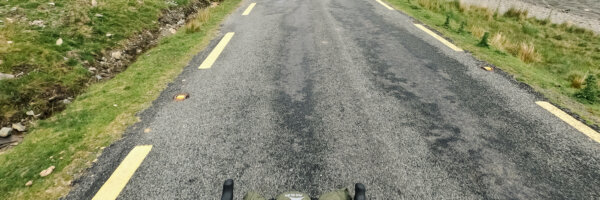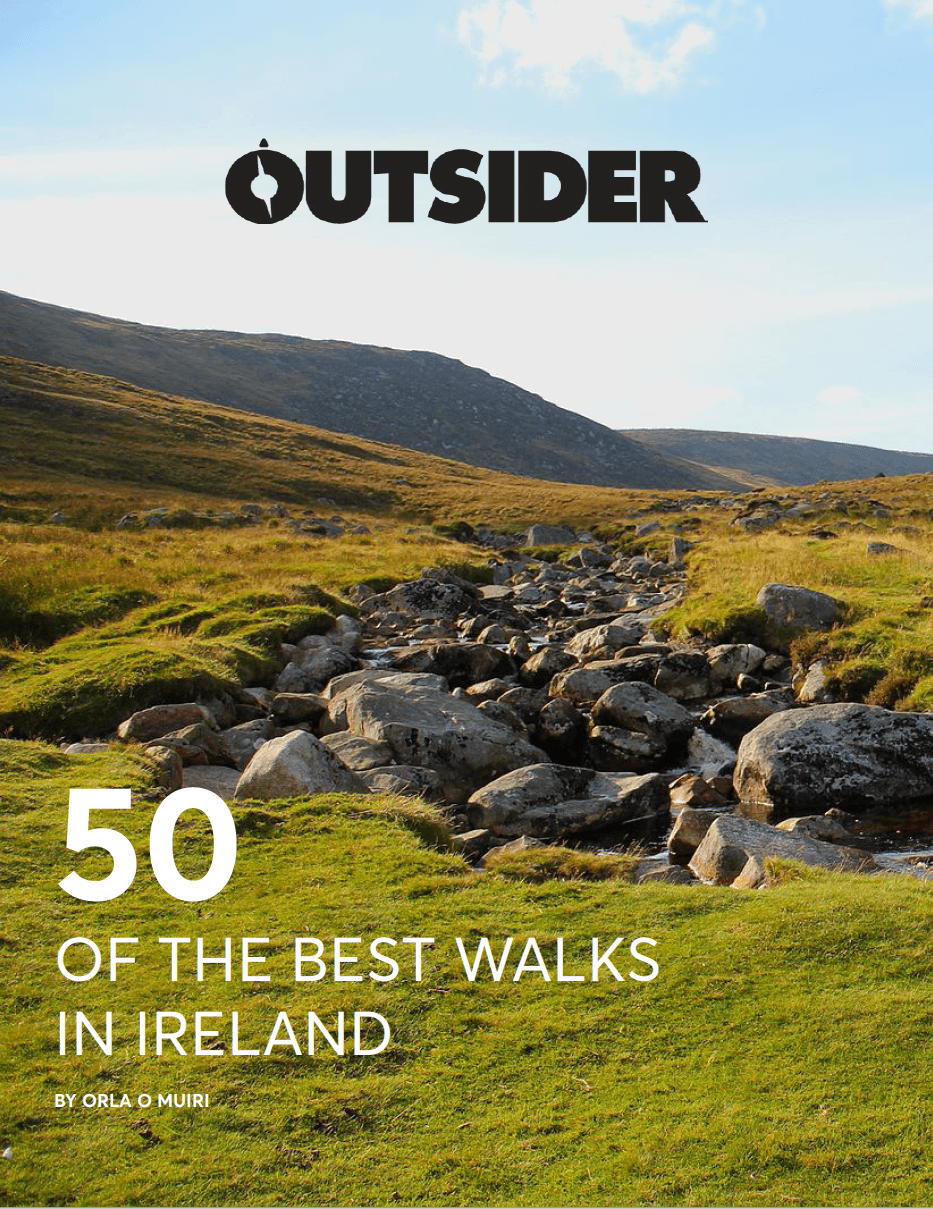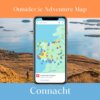Brought to you by:

Does anything beat the feeling of whizzing along on two wheels, the wind in your hair, the salty air lingering on your lips as you enjoy the breathtaking views of the Wild Atlantic Way or the North Antrim Coast?! We certainly don’t think so. And what better way to make the most of the summer weather and long days than to head out on the multi-day bikepacking adventure – it’s good for the environment, it’s good for your health and your wallet too. We guarantee you’ll be planning your next trip as soon as you finish your first one!
To make life a little easier we have popped all of the essential information you need to embark on your very first bikepacking or bike-touring adventure in Ireland. From the best routes to essential tips to make your bike adventure a cinch, we’ve got you covered.
What is Bikepacking?
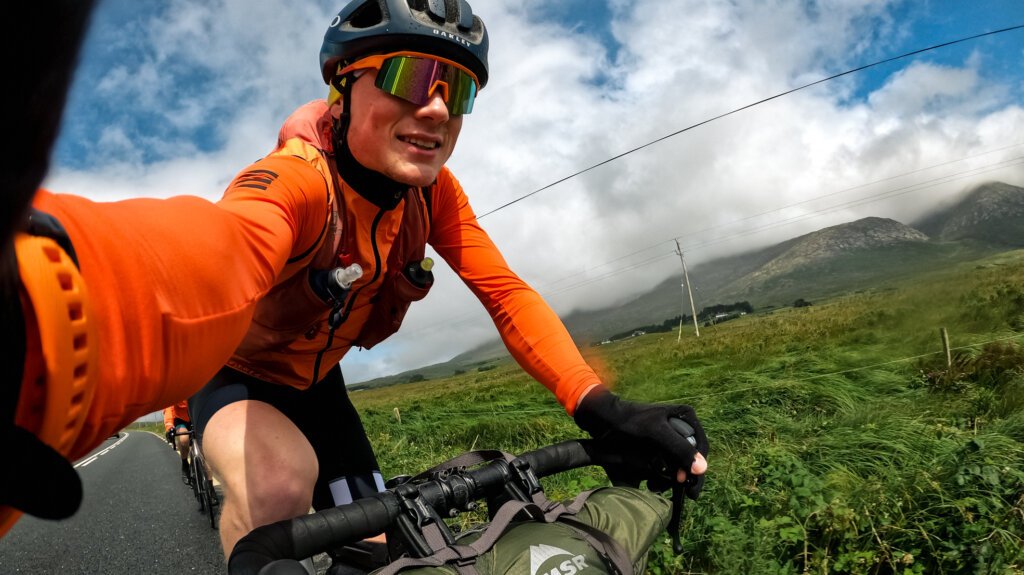
Top Tips for Bikepacking in Ireland
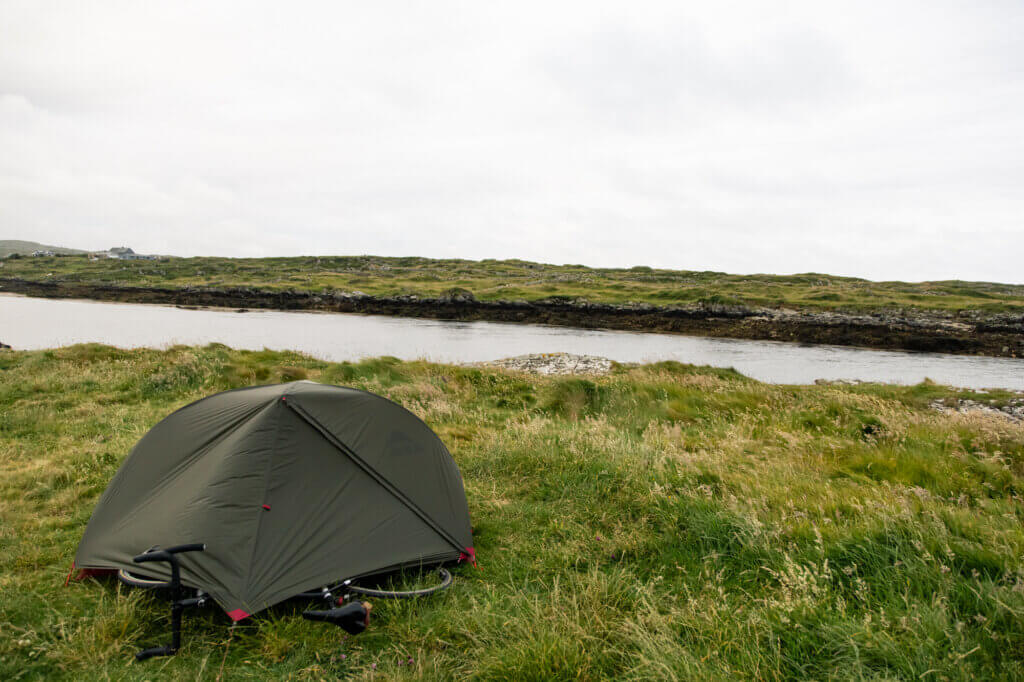
The great thing about bikepacking is that it offers you the opportunity to really unplug and get some much-needed time out from the pressures of daily life. And best of all? You don’t need lots of experience on a bike to embark on a bikepacking adventure. All you need is a bike, a lightweight tent and a can-do attitude! You can choose to cycle 10km a day or 100km a day – it is totally up to you. You can incorporate glorious lunch stops, refreshing dips and remote camping spots along the way making it a trip you will never forget.
We are incredibly lucky that Ireland lends itself brilliantly to a bike adventure thanks to its car-free greenways and quiet country lanes. And with a bike, you can reach a host of places and camping spots that a car never can!
Planning a Multi-Day Bike Adventure in Ireland: 5 Of The Best Routes
The Gear You Need For Bikepacking
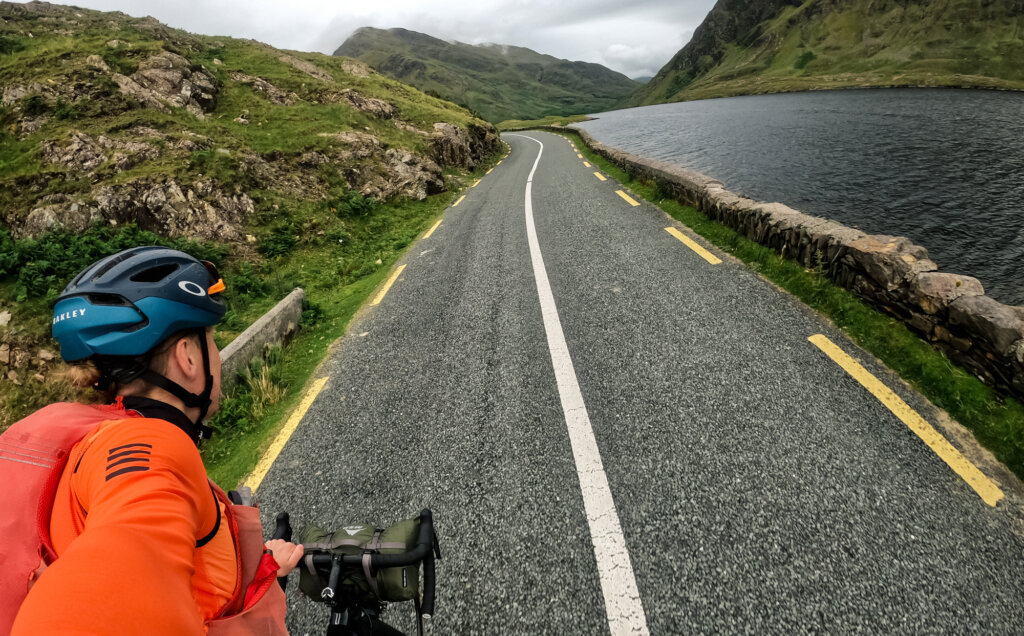
1. Essential Bikepacking Gear
Bikepacking normally involves carrying all your gear on your bike, so it is important to prioritise lightweight, multifunctional and compact items. Having said that, functionality is of paramount importance, especially for clothing.
You can invest in bikepacking-specific bags that attach to your frame, handlebars, and seat post. Hydration vests are useful too. Larger bags will put added strain on your shoulders if they are fully loaded but are perfect if you are just testing the concept out and taking on relatively short distances every day. For those looking to invest in the very best bikepacking kit, we have compiled a list of all the items we brought on our most recent bikepacking trip, check it out below.
Shelter solutions
The MSR Hubba Bikepack is a new tent that is designed specifically for bikepacking. The Hubba and Hubba Hubba are well-known backpacking tents and are broadly considered to be the best all-around backpacking tents on the market. The bikepacking version of these tents keeps all the amazing features that we have come to love with the original MSR lightweight tent range but adds a redesigned super functional, handlebar-mounted stuff sack.
A sleeping bag
Your choice of bag will depend on the weather conditions you are expecting. We would recommend a lightweight down sleeping bag to reduce pack size. The Vango Cobra 200 is an excellent lightweight option. The Cobra 200 is designed to comfortably fit individuals up to 190 cm tall, with a mummy shape that tapers from a generous shoulder width to an ergonomic foot area for optimal thermal efficiency. In warmer weather, we have even managed with a Thermolite sleeping bag liner and an insulation jacket.
A sleeping pad
These are essential for longer trips. We have only once gone bikepacking without a sleeping mat and it has resulted in very poor sleep! Nowadays there are so many exceptionally lightweight options that it is wise to bring them with you. We have used and enjoyed the Therm-A-Rest and Sea to Summit mats. We have been using the Sea To Summit Etherlight XT recently and we don’t think it can be beaten. With an impressive 10cm of thickness and an R-value (insulation value) of 3.2, it is the perfect lightweight pad for Ireland.
Food & Cooking
A compact camping stove and some lightweight cookware are worth bringing. The MSR Pocket Rocket II is a perfect stove option. We have been using the MSR Titanium cookware range recently too and have been loving how light and durable the pots are. The MSR Titan Kettle .95L is our go-to!
Outdoor Clothing
We highly recommend investing in at least one set of good-quality baselayers. Baselayers are wicking layers that sit directly against your skin and help you to regulate your temperature. Icebreaker Merino baselayers are the best in class and worth investing in. Not only are they incredibly warm for their weight they are also anti-microbial meaning that they will not go stinky nearly as quick as other options.
Great socks are very important for all outdoor activities. We would advise bringing two pairs at least. One pair to wear and one pair to wash. This is to eliminate the potential for issues with infections. We have been using Darn Tough socks recently for everything from hikes to cycles. We love them.
A lightweight windproof, waterproof, and well-fitting jacket will provide you with protection from the conditions and also keep you warm in the evenings when you stop riding. The Rab Downpour Plus 2.0 is a brilliant lightweight option that won’t break the bank. We advise visiting Great Outdoors in Dublin to try on a few different jackets before buying!
Multi-purpose headwear provides you with protection from various weather conditions.
Gloves are worthwhile year-round in Ireland! For summer adventures we recommend the Icebreaker Merino Quantum Gloves and for winter we recommend the Sealskinz Kelling Waterproof All Weather Insulated Glove.
Sunglasses will not only keep the sun out of your eyes, it will also protect them against bugs and debris. Having a pair of sunnies that fits your face is vital. We advise visiting Great Outdoors in Dublin and trying on a few pairs. The new Oakley Corridor glasses that Great Outdoors have in stock at the moment are particularly eye-catching!
Important Bike Bits
A compact bike lock, especially if you are bike-packing solo. You can get a light cable lock that will fit easily in your saddle bag.
Some people prefer classic water bottles mounted to their bike’s frame for water, others prefer a hydration reservoir like the Platypus Big Zip. Whatever your preference, make sure you carry enough water for your rides, especially in remote areas. Note where you can refill en route to make sure you don’t have to over-pack water.
Useful Extras
As you begin to go on backpacking trips you will begin to realise what optional extras you find to be worth bringing. Over the past few years of going on bikepacking trips here are some things we can’t live without!
- An Ultralight Backpack – an ultrasil backpack weighs about 70g and packs up to the size of a golf ball. It is super useful for carrying food to camp from a shop.
- Sandals or Fip Flops – lightweight footwear that will allow your feet to breathe
- Drybags – even though most bikepacking bags are waterproof, having a set of drybags to organize your gear and keep things dry has been a big plus for us.
- Power Bank – charging your phone, bike computer or bike lights on the go is super important.
- Lifesystems Sport suncream is sweat and waterproof.
- Natural anti-mosquito products which will keep the pesky insects at bay.
- Multitools are useful in a multitude of scenarios, a must!
- Microfibre towel. You will be glad of it if you decide you want to go for a swim! The ultralight Sea To Summit Airlite Towels are incredibly light and worth having!
Our Complete Bikepacking Gear Check List
2. Check the Weather
Ireland’s weather can be unpredictable, so be prepared for changing conditions. Pack appropriate clothing layers, rain gear, and a sturdy tent that can withstand windy and wet conditions. Check weather forecasts regularly before and during your trip. We use and trust; met.ie, yr.no and mountain forecast when it comes to planning nearly all of our adventures. Wind conditions play a huge role in a bikepacking trip. If possible try and avoid cycling in wind over 40km/h.
3. Practice Bike Maintenance
Ensure your bike is in good working condition before embarking on your trip. Learn and practice bike maintenance skills like changing a flat tyre, adjusting brakes and gears, and oiling the chain. We would recommend making sure that you have the following basic bike spares. All good bike shops will have a supply of these items if you are unsure about any of them we recommend visiting your local bike shop and talking to the staff there.
- Bike helmet
- Bike shoes
- Bike specific multitool
- Some spare inner tubes
- A puncture repair kit
- Tyre levers
- A mini pump, a CO2 inflator or both
4. Be Respectful of Nature and Local Communities
Respect the environment you’re cycling through. This goes for every adventure in every outdoor space. Camp responsibly, dispose of waste properly, and respect private property. Be courteous to locals you encounter on your journey and adhere to local customs and regulations. You will be surprised by how accommodating the Irish are. However, do not take this for granted, respect signage that has been erected by locals and always Leave No Trace. If wild camping adhere to the wild camping guidelines.
5. Bring Navigation Tools
A GPS device with maps enables easy step-by-step mid-ride navigation. Some GPS units even have a built-in search feature for finding attractions, towns or shops. For our rides we have been using a Garmin Fenix, it works great and has excellent battery life! Great Outdoors also has stock of some bike computers, these are more suited to cycling as the displays are bigger and clearer, and the battery life lasts longer. The Garmin Edge 540 Solar is a perfect option given its long battery life and solar charging capabilities.
Additionally, having a backup power source like a portable charger for your electronic devices is essential. Our Garmin watch has a battery size of 424mAh, and an iPhone has a battery of approximately 3000mAh consider purchasing a battery pack that will charge them multiple times. We bring a 10,000mAh battery on all our multi-day trips.
6. Stay Hydrated and Well-Fueled
Bring an appropriate collection of food and electrolytes that you know you can rely on mid-ride.
Clif Energy Bars are a favourite of many outdoor enthusiasts. We have also recently tried the TORQ Energy Flapjacks and think they are an awesome option too. Fulfil Protein Bars are worth having too as a way of kickstarting your recovery with a protein boost. Gels are brilliant for quick-release energy to get you out of a slump, again the TORQ Gels are brilliant. They have all sorts of delicious flavours like rhubarb and custard, apple crumble, and caramel latte! They are well worth trying!
In our bottles, especially for long or multi-day rides we always have electrolytes. Electrolyte drinks are designed to keep you hydrated and replenish the salts you lose through exercising. The Powerbar Electrolytes work perfectly.
Although one great thing about bikepacking in Ireland is that you are rarely too far from food. Many countryside pubs serve hot food and many small corner shops and petrol stations will have basic groceries. Research and mark these places, especially for more remote areas.
7. Safety First
Always wear a helmet.
A set of good-quality bike lights is worth having year-round. Even if you do not intend on riding in the dark it is good to have them in case you are delayed en route and end up riding later than intended. If you want to invest in the best, consider the Garmin Varia front and rear lights. With more features than most bike computers, these lights are amazing bits of kit!
Being visible on the road is of course super important. We have been using this lightweight high viz that doesn’t flap in the wind and is easy to pack away!
Follow traffic rules and be mindful of road conditions. While we do not advise tackling an ambitious bikepacking route alone we respect that some people may like the challenge. If this is the case for you, make sure someone knows your whereabouts. Inform someone of your itinerary and estimated time of arrival at your destinations.
Carry a basic first-aid kit, know basic first-aid techniques and have emergency contact numbers written on the back of your phone case or somewhere else that is obvious.
8. Embrace the Experience of Bikepacking
Bikepacking in Ireland offers incredible opportunities for adventure and discovery. Take the time to soak in the stunning landscapes, interact with locals, and enjoy the unique charm of each place you visit.
9. Plan Your Bikepacking Route
Research and plan your route in advance. Consider the terrain, distance, and difficulty level that suits your skill and fitness. Use online resources such as Hiiker, maps, or guidebooks to identify scenic trails, quiet country roads, and places of interest along the way. One of our favourite tools for route planning is the Strava heat map. This shows you what trails have seen the most traffic, and therefore may be worth visiting, or have seen little to no traffic which may mean they are old or impassable.



